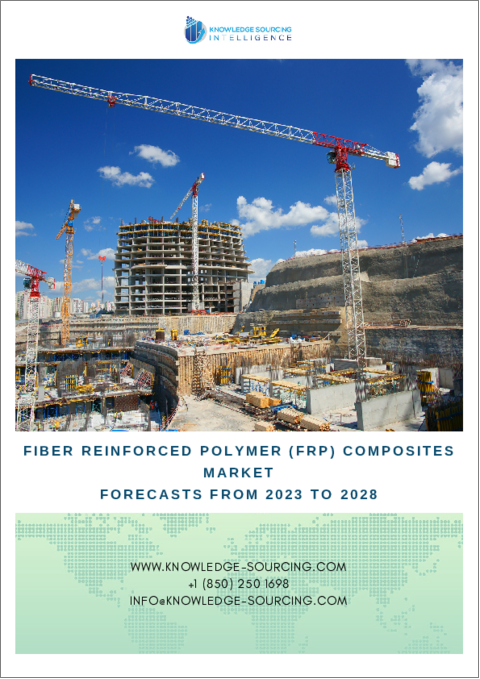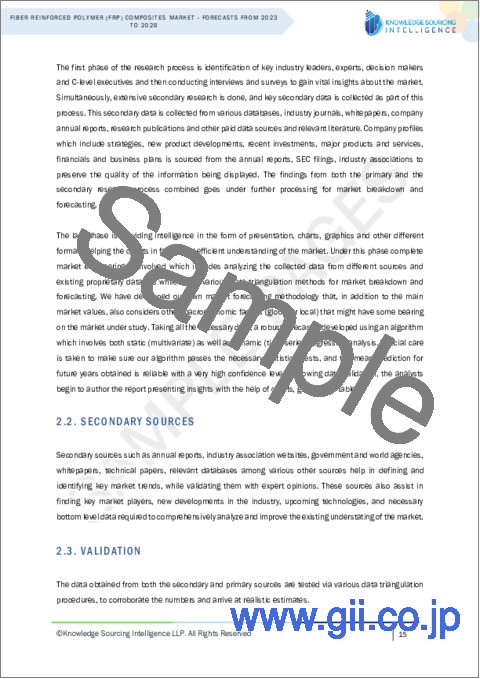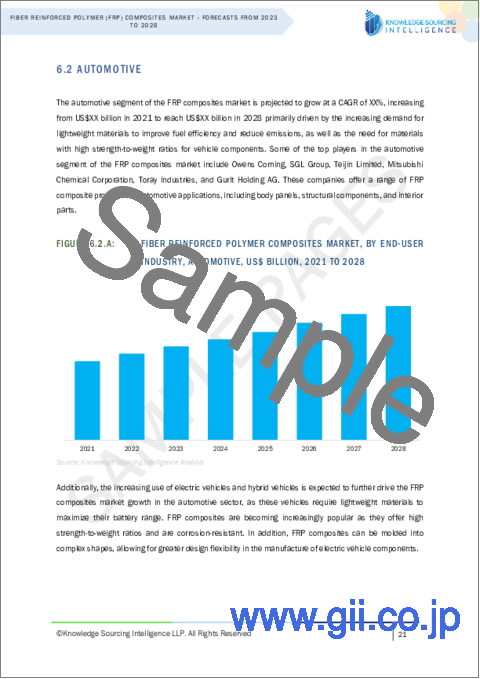|
|
市場調査レポート
商品コード
1295307
繊維強化ポリマー(FRP)複合材料市場-2023年から2028年までの予測Fiber Reinforced Polymer (FRP) Composites Market - Forecasts from 2023 to 2028 |
||||||
カスタマイズ可能
|
|||||||
| 繊維強化ポリマー(FRP)複合材料市場-2023年から2028年までの予測 |
|
出版日: 2023年06月02日
発行: Knowledge Sourcing Intelligence
ページ情報: 英文 138 Pages
納期: 即日から翌営業日
|
- 全表示
- 概要
- 目次
繊維強化ポリマー(FRP)複合材料市場は、2021年の2,247億2,300万米ドルから2028年には3,812億1,200万米ドルへとCAGR 7.84%で成長すると予測されています。
建設、運輸、防衛分野が主に世界市場を牽引しています。繊維強化ポリマー複合材料は、建設分野では鉄骨建築の代替品として採用されています。ポリマーでできた複合材料は、鋼鉄よりも25%軽く、25%強いです。また、錆や磨耗にも強いです。自動車部品は、アルミ製自動車部品よりも軽く、強く、成形しやすいため、より安全で燃費が良いです。これらは、自動車の構造要素の作成に採用されています。
さらに、予測期間中、電気自動車市場の拡大により、FRP複合材料の需要も増加すると予想されます。複合材料の使用は、ドライブトレインを軽量化することで、EVの航続距離延長に貢献します。また、駆動システムの機械的・電気的特性も向上します。繊維強化ポリマー(FRP)複合材料市場は、建設部門と輸送部門における需要の高まりによって牽引されています。
輸送分野では、自動車から船舶、ボート、飛行機、ヘリコプターに至るまで、あらゆるものに繊維強化ポリマー(FRP)複合材料が幅広く使用されています。
重量とコストを考慮すると、繊維強化ポリマー(FRP)複合材料は、輸送において鉄やアルミニウムのような従来の材料の理想的な代替品です。構造重量を軽減し、耐腐食性を向上させる海上の水辺や船舶では、FRPは木材の完璧な代替品となります。さらに、ボーイング社によれば、全世界で43,110機以上の新造航空機の納入が必要であり、その70%以上が単通路機であると予測され、2040年までに32,270機以上の需要が増加すると予測されています。過去10年間の旅客航空便のCAGRは6.5%で、長期平均の5%を大幅に上回っています。旅客需要に対応するため、世界中の数多くの航空会社が新型機を導入し、保有機数を増やしました。
同様に、OCIAは、2021年には世界中で8,014万台の自動車が生産されると推定しました。2020年と比較して、生産能力は3%増加しました。その結果、自動車製造と航空機納入の増加により、繊維強化ポリマー製複合材料の需要が増加すると予測されます。
市場開拓:
- 2021年7月、The Digital Forgeと名付けられた金属と炭素繊維の統合積層造形プラットフォームを開発した米国のMarkforged社は、航空宇宙や防衛を含む高度に規制された産業で操業するメーカーを支援することを発表しました。
エンドユーザー産業に基づくと、繊維強化ポリマー(FRP)複合材料市場は自動車分野でプラス成長が見込まれています。
自動車市場は主に、燃費の向上と排出ガスの削減を目的とした軽量材料への需要の高まりと、車両部品の高強度重量比材料へのニーズによって牽引されています。FRP複合材料市場の自動車分野のトップ企業には、オーエンズ・コーニング、SGLグループ、帝人株式会社、三菱化学株式会社、東レ株式会社、Gurit Holding AGなどがあります。これらの企業は、ボディパネル、構造部品、内装部品など、自動車用途のFRP複合材製品を幅広く提供しています。
さらに、電気自動車やハイブリッド車の使用が増加しており、これらの自動車はバッテリーの航続距離を最大化するために軽量材料を必要とするため、自動車分野におけるFRP複合材市場の成長をさらに促進すると予想されています。その結果、FRP複合材料は高い強度対重量比を提供し、耐腐食性であるため、ますます人気が高まっています。また、FRP複合材料は複雑な形状に成形できるため、電気自動車部品の製造において設計の自由度を高めることができます。
電気自動車市場は、クリーン・エネルギーの中でも急速に発展しているダイナミックな分野です。バッテリー技術の進歩と、気候変動や大気汚染に対する懸念の高まりにより、電気自動車の需要はかつてない勢いで伸びています。この成長の原動力となっているのは、政府の奨励策や規制、充電インフラの改善、自動車メーカーによる斬新な電気自動車モデルの開発など、複合的な要因です。電気自動車はバッテリーの航続距離を最大化するために軽量材料を必要とするため、FRP複合材料は高い強度対重量比を提供し、耐腐食性であることから、ますます人気が高まっています。また、FRP複合材料は複雑な形状に成形できるため、電気自動車部品の製造において設計の柔軟性を高めることができます。
世界の繊維強化ポリマー(FRP)複合材料市場では北米が大きなシェアを占めています。
地域別に見ると、繊維強化ポリマー(FRP)複合材料市場は北米、南米、欧州、中東・アフリカ、アジア太平洋に区分されます。
北米では航空宇宙産業がFRP複合材料の主要な消費者であり、燃費を向上させ二酸化炭素排出量を削減できる軽量材料のニーズがその原動力となっています。FRP複合材は、主翼、胴体、尾翼部分など様々な航空機部品に使用されており、その需要は今後数年で拡大すると予想されています。この要因は、北米のFRP複合材市場の成長を引き続き促進すると予想されます。北米では建設業界もFRP複合材料の重要な消費者であり、特にインフラの強化や改修に利用されています。FRP複合材料は、高強度重量比、耐食性、施工の容易さなど、従来の材料と比較していくつかの利点があります。同地域ではインフラ整備への投資が増加しており、今後数年間はFRP複合材の需要を牽引すると予想されます。米国国勢調査局によると、2020年の米国の建設支出は1兆4,400億米ドルと推定されています。高速道路、橋梁、空港などのインフラ整備への投資の増加が、建設業界におけるFRP複合材の需要を促進すると予想されています。
目次
第1章 イントロダクション
- 市場概要
- 市場の定義
- 調査範囲
- 市場セグメンテーション
- 通貨
- 前提条件
- 基準年と予測年のタイムライン
第2章 調査手法
- 調査デザイン
- 調査プロセス
第3章 エグゼクティブサマリー
- 調査ハイライト
第4章 市場力学
- 市場促進要因
- 市場抑制要因
- ポーターのファイブフォース分析
- 業界バリューチェーン分析
第5章 繊維強化ポリマー(FRP)複合材料市場:タイプ別
- イントロダクション
- アラミド繊維強化ポリマー(AFRP)複合材料
- ガラス繊維強化ポリマー(GFRP)複合材料
- 玄武岩繊維強化ポリマー(BFRP)複合材料
- 炭素繊維強化ポリマー(CFRP)複合材料
- その他
第6章 繊維強化ポリマー(FRP)複合材料市場:エンドユーザー業界別
- イントロダクション
- 自動車
- 電気・電子
- 建築と建設
- 防衛
- その他
第7章 繊維強化ポリマー(FRP)複合材料市場:地域別
- イントロダクション
- 北米
- 米国
- カナダ
- メキシコ
- 南米
- ブラジル
- アルゼンチン
- その他
- 欧州
- ドイツ
- フランス
- 英国
- イタリア
- その他
- 中東・アフリカ
- サウジアラビア
- 南アフリカ
- その他
- アジア太平洋
- 中国
- インド
- 日本
- 韓国
- 台湾
- タイ
- インドネシア
- その他
第8章 競合環境と分析
- 主要企業と戦略分析
- 新興企業と市場収益性
- 合併、買収、合意およびコラボレーション
- ベンダー競争力マトリックス
第9章 企業プロファイル
- American Fiberglass Rebar
- Mitsubishi Chemical Corporation
- SGL Carbon SE
- DowAksa
- Engineered Composites Ltd
- TUF-BAR
- Owens Corning
- Advanced Composites Inc.
- Aeron Composite Pvt Ltd
- Dextra Group
The fiber reinforced polymer (FRP) composites market is predicted to grow at a CAGR of 7.84% from US$224.723 billion in 2021 to US$381.212 billion by 2028.
The construction, transportation, and defense sectors primarily drive the global market. The fiber reinforced polymer composites are employed as a substitute for steel building constructions in the construction sector. Composites made of polymers are 25% lighter and 25% stronger than steel. They also provide resistance to rust and wear and tear. The automobile parts are lighter, stronger, and more moldable than aluminum car parts, making them safer and more fuel-efficient. They are employed in the creation of structural elements for automobiles.
Moreover, it is anticipated that during the projected period, demand for FRP composites will also increase due to the expansion of the electric vehicle market. By lowering the weight of the drive train, the use of composite materials will aid in extending the range of EVs. Also, it will enhance the mechanical and electrical characteristics of the driving systems. The fiber-reinforced polymer (FRP) composites market is driven by rising demand in the construction and transportation sectors.
The transportation sector extensively uses fiber-reinforced polymer (FRP) composites in everything from cars to ships and boats to planes and helicopters.
Due to weight and cost considerations, fiber-reinforced polymer (FRP) composite material is an ideal substitute for traditional materials like steel or aluminum in transportation. In maritime waterfront settings or on ships, where they lessen the structural weight and improve corrosion resistance, FRPs are the perfect substitutes for wood. Further, worldwide deliveries of more than 43,110 new airplanes are required, as stated in Boeing, with over 70% of new deliveries projected to be single-aisle aircraft, and demand for more than 32,270 aircraft is expected to increase by 2040. The average annual growth rate for passenger air travel over the past ten years was 6.5%, significantly higher than the long-term average of 5%. To meet passenger demand, numerous airlines worldwide increased the number of aircraft in their fleets by taking delivery of new aircraft.
Similarly, OCIA estimated that 80.14 million automobiles will be produced worldwide in 2021. Compared to 2020, the production capacity grew by 3%. Consequently, an increase in automotive vehicle manufacturing and aircraft deliveries is projected to increase demand for composite materials made of fiber-reinforced polymer.
Market Developments:
- In July 2021, Markforged, an American company that developed an integrated metal and carbon fiber additive manufacturing platform named The Digital Forge, announced its commitment to supporting manufacturers operating in highly-regulated industries, including aerospace and defense.
Based on the end-user industry, the fiber-reinforced polymer (FRP) composites market is expected to grow positively in the automotive segment.
The automotive market is primarily driven by the increasing demand for lightweight materials to improve fuel efficiency and reduce emissions and the need for materials with high strength-to-weight ratios for vehicle components. Some of the top players in the automotive segment of the FRP composites market include Owens Corning, SGL Group, Teijin Limited, Mitsubishi Chemical Corporation, Toray Industries, and Gurit Holding AG. These companies offer a range of FRP composite products for automotive applications, including body panels, structural components, and interior parts.
Additionally, the increasing use of electric and hybrid vehicles is expected to drive further the growth of the FRP composites market in the automotive sector, as these vehicles require lightweight materials to maximize their battery range. As a result, FRP composites are becoming increasingly popular as they offer high strength-to-weight ratios and are corrosion-resistant. In addition, FRP composites can be molded into complex shapes, allowing for greater design flexibility in manufacturing electric vehicle components.
The electric car market is a rapidly evolving and dynamic area of clean energy. With advancements in battery technology and increasing concerns about climate change and air pollution, the demand for electric cars is growing at an unprecedented rate. This growth is driven by a combination of factors, including government incentives and regulations, improvements in charging infrastructure, and the development of new and innovative electric car models by automakers. As electric vehicles require lightweight materials to maximize their battery range, FRP composites are becoming increasingly popular as they offer high strength-to-weight ratios and are corrosion-resistant. In addition, FRP composites can be molded into complex shapes, allowing for greater design flexibility in manufacturing electric vehicle components.
North America accounted for a major share of the global fiber reinforced polymer (FRP) composites market.
By geography, the fiber reinforced polymer (FRP) composites market has been segmented into North America, South America, Europe, the Middle East and Africa, and the Asia Pacific.
The aerospace industry is a key consumer of FRP composites in North America, driven by the need for lightweight materials that can improve fuel efficiency and reduce carbon emissions. FRP composites are used in various aircraft components, such as wings, fuselage, and tail sections, and their demand is expected to grow in the coming years. This driver is expected to continue driving growth in the North American FRP composites market. The construction industry is also a significant consumer of FRP composites in North America, especially for strengthening and retrofitting infrastructure. FRP composites offer several advantages over traditional materials, such as a high strength-to-weight ratio, corrosion resistance, and ease of installation. The increasing investments in infrastructure development in the region are expected to drive demand for FRP composites in the coming years. According to the US Census Bureau, construction spending in the US was estimated at $1.44 trillion in 2020. The increasing investments in infrastructure development, such as highways, bridges, and airports, are expected to drive demand for FRP composites in the construction industry.
Segmentation:
BY TYPE
- Aramid Fiber Reinforced Polymer (AFRP) Composites
- Glass Fiber Reinforced Polymer (GFRP) Composites
- Basalt Fiber Reinforced Polymer (BFRP) Composites
- Carbon Fiber Reinforced Polymer (CFRP) Composites
- Others
BY END-USER INDUSTRY
- Automotive
- Electrical & Electronics
- Building & Construction
- Defense
- Others
BY GEOGRAPHY
- North America
- USA
- Canada
- Mexico
- South America
- Brazil
- Argentina
- Others
- Europe
- Germany
- France
- United Kingdom
- Italy
- Others
- Middle East and Africa
- Saudi Arabia
- South Africa
- Others
- Asia Pacific
- China
- India
- Japan
- South Korea
- Taiwan
- Thailand
- Indonesia
- Others
TABLE OF CONTENTS
1. INTRODUCTION
- 1.1. Market Overview
- 1.2. Market Definition
- 1.3. Scope of the Study
- 1.4. Market Segmentation
- 1.5. Currency
- 1.6. Assumptions
- 1.7. Base, and Forecast Years Timeline
2. RESEARCH METHODOLOGY
- 2.1. Research Design
- 2.2. Research Process
3. EXECUTIVE SUMMARY
- 3.1. Research Highlights
4. MARKET DYNAMICS
- 4.1. Market Drivers
- 4.2. Market Restraints
- 4.3. Porter's Five Force Analysis
- 4.3.1. Bargaining Power of Suppliers
- 4.3.2. Bargaining Power of Buyers
- 4.3.3. Threat of New Entrants
- 4.3.4. Threat of Substitutes
- 4.3.5. Competitive Rivalry in the Industry
- 4.4. Industry Value Chain Analysis
5. FIBER REINFORCED POLYMER (FRP) COMPOSITES MARKET, BY TYPE
- 5.1. Introduction
- 5.2. Aramid Fiber Reinforced Polymer (AFRP) Composites
- 5.3. Glass Fiber Reinforced Polymer (GFRP) Composites
- 5.4. Basalt Fiber Reinforced Polymer (BFRP) Composites
- 5.5. Carbon Fiber Reinforced Polymer (CFRP) Composites
- 5.6. Others
6. FIBER REINFORCED POLYMER (FRP) COMPOSITES MARKET, BY END-USER INDUSTRY
- 6.1. Introduction
- 6.2. Automotive
- 6.3. Electrical & Electronics
- 6.4. Building & Construction
- 6.5. Defense
- 6.6. Others
7. FIBER REINFORCED POLYMER (FRP) COMPOSITES MARKET, BY GEOGRAPHY
- 7.1. Introduction
- 7.2. North America
- 7.2.1. USA
- 7.2.2. Canada
- 7.2.3. Mexico
- 7.3. South America
- 7.3.1. Brazil
- 7.3.2. Argentina
- 7.3.3. Others
- 7.4. Europe
- 7.4.1. Germany
- 7.4.2. France
- 7.4.3. United Kingdom
- 7.4.4. Italy
- 7.4.5. Others
- 7.5. Middle East and Africa
- 7.5.1. Saudi Arabia
- 7.5.2. South Africa
- 7.5.3. Others
- 7.6. Asia Pacific
- 7.6.1. China
- 7.6.2. India
- 7.6.3. Japan
- 7.6.4. South Korea
- 7.6.5. Taiwan
- 7.6.6. Thailand
- 7.6.7. Indonesia
- 7.6.8. Others
8. COMPETITIVE ENVIRONMENT AND ANALYSIS
- 8.1. Major Players and Strategy Analysis
- 8.2. Emerging Players and Market Lucrativeness
- 8.3. Mergers, Acquisitions, Agreements, and Collaborations
- 8.4. Vendor Competitiveness Matrix
9. COMPANY PROFILES
- 9.1. American Fiberglass Rebar
- 9.2. Mitsubishi Chemical Corporation
- 9.3. SGL Carbon SE
- 9.4. DowAksa
- 9.5. Engineered Composites Ltd
- 9.6. TUF-BAR
- 9.7. Owens Corning
- 9.8. Advanced Composites Inc.
- 9.9. Aeron Composite Pvt Ltd
- 9.10. Dextra Group





